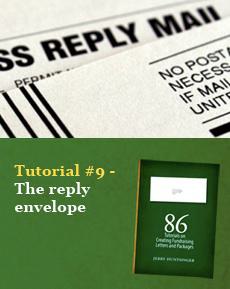Tutorial 9: The reply envelope
If you want to raise money – make sure you include a reply envelope. There are several decisions you need to make and each decision affects the type of package you’ll be creating.
- Written by
- Jerry Huntsinger
- Added
- February 20, 2019
Postage-paid envelopes

This kind of envelope guarantees that the organisation will pay the return postage.
In the past, virtually all direct mail packages included postage-paid envelopes. But with postage cost increases, many organisations have tested and found that their net income has increased by omitting the postage-paid envelope. They still include a reply envelope, but it’s up to the donor to put on a postage stamp.
There are occasions when a postage-paid envelope is appropriate. When you use this procedure you must carefully adhere to all the postal regulations that dictate what areas of the envelope can be printed as well as what is to be printed on the envelope.
(If you’re mailing a solicitation package to your high value donors you may want to include a pre-stamped reply envelope. This may increase your response rate, but be aware that it will also increase your cost as you’ll be paying for postage on ALL the envelopes, even if the donor doesn’t send it back. GC.)
Non-postage-paid envelopes
As the trend increases to use these envelopes, it also frees up the reply envelope from postal regulations and allows the organisation to be a bit more creative in using the envelope. For example, the typeface you use on the envelope, the omission of the postal bars, the opportunity to put a note on the envelope such as ‘earthquake project’, and so on.
The colour of the reply envelope should stand out from the rest of the package, so that the donor has a strong hint about what you wish to be done with the envelope. If the envelope blends in too much, then you may have a pretty package, but the envelope doesn’t call out for action.
This is an area where you can design with two extremes in mind. One design might be a very business-like envelope, quite proper and similar to the envelopes people are used to receiving for payment of water bills, light bills, telephone bills, etc. The other extreme is to design an envelope that calls out for attention.
© SOFII Foundation 2010-2014.

















